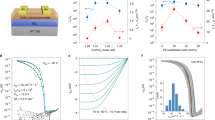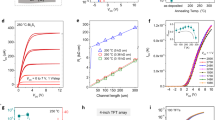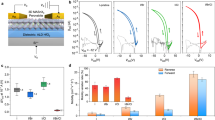Abstract
Metal oxide thin-film transistors are increasingly used in the driving backplanes of organic light-emitting diode displays. Commercial devices currently rely on metal oxides processed via physical vapour deposition methods, but the use of solution-based processes could provide a simpler, higher-throughput approach that would be more cost effective. However, creating oxide transistors with high carrier mobility and bias-stable operation using such processes has proved challenging. Here we show that transistors with high electron mobility (50 cm2 V−1 s−1) and operational stability can be fabricated from solution-processed multilayer channels composed of ultrathin layers of indium oxide, zinc oxide nanoparticles, ozone-treated polystyrene and compact zinc oxide. Insertion of the ozone-treated polystyrene interlayer passivates electron traps in the channel and reduces bias-induced instability during continuous transistor operation over a period of 24 h and under a high electric-field flux density (2.1 × 10−6 C cm−2). Furthermore, incorporation of the pre-synthesized aluminium-doped zinc oxide nanoparticles enables controlled n-type doping of the hybrid channels, providing additional control over the operating characteristics of the transistors.
This is a preview of subscription content, access via your institution
Access options
Access Nature and 54 other Nature Portfolio journals
Get Nature+, our best-value online-access subscription
$29.99 / 30 days
cancel any time
Subscribe to this journal
Receive 12 digital issues and online access to articles
$119.00 per year
only $9.92 per issue
Buy this article
- Purchase on Springer Link
- Instant access to full article PDF
Prices may be subject to local taxes which are calculated during checkout





Similar content being viewed by others
Data availability
The data that support the plots within this paper and other findings of this study are available from the corresponding author upon reasonable request.
References
Tang, J. et al. Flexible CMOS integrated circuits based on carbon nanotubes with sub-10 ns stage delays. Nat. Electron. 1, 191–196 (2018).
Lin, Z. et al. Solution-processable 2D semiconductors for high-performance large-area electronics. Nature 562, 254–258 (2018).
Jung, E. H. et al. Efficient, stable and scalable perovskite solar cells using poly(3-hexylthiophene). Nature 567, 511–515 (2019).
Faber, H. et al. Heterojunction oxide thin-film transistors with unprecedented electron mobility grown from solution. Sci. Adv. 3, e1602640 (2017).
Kim, G. H. et al. Inkjet-printed InGaZnO thin film transistor. Thin Solid Films 517, 4007–4010 (2009).
Takata, R. et al. Scalability and homogeneity of slot die-coated metal oxide semiconductor for TFTs. J. Soc. Inf. Disp. 24, 381–385 (2016).
Solution based OLEDs. OLED-info https://www.oled-info.com/taxonomy/term/251/blank.htm (2019).
Kim, M. G., Kanatzidis, M. G., Facchetti, A. & Marks, T. J. Low-temperature fabrication of high-performance metal oxide thin-film electronics via combustion processing. Nat. Mater. 10, 382–388 (2011).
Hosono, H. Recent progress in transparent oxide semiconductors: materials and device application. Thin Solid Films 515, 6000–6014 (2007).
Thomas, S. R., Pattanasattayavong, P. & Anthopoulos, T. D. Solution-processable metal oxide semiconductors for thin-film transistor applications. Chem. Soc. Rev. 42, 6910–6923 (2013).
Yu, X., Marks, T. J. & Facchetti, A. Metal oxides for optoelectronic applications. Nat. Mater. 15, 383–396 (2016).
Fortunato, E., Barquinha, P. & Martins, R. Oxide semiconductor thin-film transistors: a review of recent advances. Adv. Mater. 24, 2945–2986 (2012).
Adamopoulos, G. et al. Spray-deposited Li-doped ZnO transistors with electron mobility exceeding 50 cm2/Vs. Adv. Mater. 22, 4764–4769 (2010).
Yu, X. et al. Spray-combustion synthesis: efficient solution route to high-performance oxide transistors. Proc. Natl Acad. Sci. USA 112, 3217–3222 (2015).
Wang, B. H. et al. Solution-processed all-oxide transparent high-performance transistors fabricated by spray-combustion synthesis. Adv. Electron. Mater. 2, 1500427 (2016).
Kamiya, T. & Hosono, H. Material characteristics and applications of transparent amorphous oxide semiconductors. NPG Asia Mater. 2, 15–22 (2010).
Nomura, K., Kamiya, T., Hirano, M. & Hosono, H. Origins of threshold voltage shifts in room-temperature deposited and annealed a-In-Ga-Zn-O thin-film transistors. Appl. Phys. Lett. 95, 013502 (2009).
Nomura, K., Kamiya, T. & Hosono, H. Highly stable amorphous In-Ga-Zn-O thin-film transistors produced by eliminating deep subgap defects. Appl. Phys. Lett. 99, 053505 (2011).
Sun, B. & Sirringhaus, H. Solution-processed zinc oxide field-effect transistors based on self-assembly of colloidal nanorods. Nano Lett. 5, 2408–2413 (2005).
Lin, Y. H., Faber, H., Rossbauer, S. & Anthopoulos, T. D. Solution-processed ZnO nanoparticle-based transistors via a room-temperature photochemical conversion process. Appl. Phys. Lett. 102, 193516 (2013).
Sabri, M. M. et al. Hydroxyl radical-assisted decomposition and oxidation in solution-processed indium oxide thin-film transistors. J. Mater. Chem. C 3, 7499–7505 (2015).
Faber, H. et al. Impact of oxygen plasma treatment on the device performance of zinc oxide nanoparticle-based thin-film transistors. ACS Appl. Mater. Interfaces 4, 1693–1696 (2012).
Okamura, K., Mechau, N., Nikolova, D. & Hahn, H. Influence of interface roughness on the performance of nanoparticulate zinc oxide field-effect transistors. Appl. Phys. Lett. 93, 083105 (2008).
Bubel, S. & Schmechel, R. Mechanical layer compaction for dispersion processed nanoparticulate zinc oxide thin film transistors. Microelectron. Eng. 96, 36–39 (2012).
Li, F. M. et al. Zinc oxide nanostructures and high electron mobility nanocomposite thin film transistors. IEEE Trans. Electron Dev. 55, 3001–3011 (2008).
Khim, D. et al. Modulation-doped In2O3/ZnO heterojunction transistors processed from solution. Adv. Mater. 29, 1605837 (2017).
Lin, Y.-H. et al. High electron mobility thin-film transistors based on solution-processed semiconducting metal oxide heterojunctions and quasi-superlattices. Adv. Sci. 2, 1500058 (2015).
Venkatesan, S., Ngo, E., Khatiwada, D., Zhang, C. & Qiao, Q. Q. Enhanced lifetime of polymer solar cells by surface passivation of metal oxide buffer layers. ACS Appl. Mater. Interfaces 7, 16093–16100 (2015).
Zhong, P., Ma, X. & Xi, H. Passivating ZnO surface states by C60 pyrrolidine tris-acid for hybrid solar cells based on poly(3-hexylthiophene)/ZnO nanorod arrays. Polymers 10, 4 (2018).
Olziersky, A. et al. Insight on the SU-8 resist as passivation layer for transparent Ga2O3–In2O3–ZnO thin-film transistors. J. Appl. Phys. 108, 064505 (2010).
Panagiotopoulos, N. T. et al. Nanocomposite catalysts producing durable, super-black carbon nanotube systems: applications in solar thermal harvesting. ACS Nano 6, 10475–10485 (2012).
Davidson, M. R., Mitchell, S. A. & Bradley, R. H. Surface studies of low molecular weight photolysis products from UV-ozone oxidised polystyrene. Surf. Sci. 581, 169–177 (2005).
Klein, R. J., Fischer, D. A. & Lenhart, J. L. Systematic oxidation of polystyrene by ultraviolet-ozone, characterized by near-edge X-ray absorption fine structure and contact angle. Langmuir 24, 8187–8197 (2008).
Huang, W., Fan, H. D., Zhuang, X. M. & Yu, J. S. Effect of UV/ozone treatment on polystyrene dielectric and its application on organic field-effect transistors. Nanoscale Res. Lett. 9, 479 (2014).
Baeg, K. J., Noh, Y. Y., Ghim, J., Lim, B. & Kim, D. Y. Polarity effects of polymer gate electrets on non-volatile organic field-effect transistor memory. Adv. Funct. Mater. 18, 3678–3685 (2008).
Shih, C. C. et al. High performance transparent transistor memory devices using nano-floating gate of polymer/ZnO nanocomposites. Sci. Rep. 6, 20129 (2016).
Chen, Y. et al. Polymer doping enables a two-dimensional electron gas for high-performance homojunction oxide thin-film transistors. Adv. Mater. 31, 1805082 (2019).
Zschieschang, U., Weitz, R. T., Kern, K. & Klauk, H. Bias stress effect in low-voltage organic thin-film transistors. Appl. Phys. A 95, 139–145 (2009).
Sung, S.-Y. et al. Effects of ambient atmosphere on the transfer characteristics and gate-bias stress stability of amorphous indium-gallium-zinc oxide thin-film transistors. Appl. Phys. Lett. 96, 102107 (2010).
Liu, P.-T., Chou, Y.-T. & Teng, L.-F. Environment-dependent metastability of passivation-free indium zinc oxide thin film transistor after gate bias stress. Appl. Phys. Lett. 95, 233504 (2009).
Jeong, J. K., Yang, H. W., Jeong, J. H., Mo, Y.-G. & Kim, H. D. Origin of threshold voltage instability in indium-gallium-zinc oxide thin film transistors. Appl. Phys. Lett. 93, 123508 (2008).
Chen, Y.-C. et al. Bias-induced oxygen adsorption in zinc tin oxide thin film transistors under dynamic stress. Appl. Phys. Lett. 96, 262104 (2010).
Mottram, A. D. et al. Quasi two-dimensional dye-sensitized In2O3 phototransistors for ultrahigh responsivity and photosensitivity photodetector applications. ACS Appl. Mater. Interfaces 8, 4894–4902 (2016).
Grünewald, M., Thomas, P. & Würtz, D. A simple scheme for evaluating field effect data. Phys. Status Solidi B 100, K139–K143 (1980).
Bubel, S. & Chabinyc, M. L. Model for determination of mid-gap states in amorphous metal oxides from thin film transistors. J. Appl. Phys. 113, 234507 (2013).
Cho, E. N., Kang, J. H., Kim, C. E., Moon, P. & Yun, I. Analysis of bias stress instability in amorphous InGaZnO thin-film transistors. IEEE Trans. Device Mater. Rel. 11, 112–117 (2011).
Wolff, C. M. et al. Reduced interface-mediated recombination for high open-circuit voltages in CH3NH3PbI3 solar cells. Adv. Mater. 29, 1700159 (2017).
Qi, W., Qingfeng, D., Tao, L., Alexei, G. & Jinsong, H. Thin insulating tunneling contacts for efficient and water‐resistant perovskite solar cells. Adv. Mater. 28, 6734–6739 (2016).
Ton-That, C., Campbell, P. A. & Bradley, R. H. Frictional force microscopy of oxidized polystyrene surfaces measured using chemically modified probe tips. Langmuir 16, 5054–5058 (2000).
Murakami, T. N. et al. Surface modification of polystyrene and poly(methyl methacrylate) by active oxygen treatment. Colloids Surf. B 29, 171–179 (2003).
Wöll, C. The chemistry and physics of zinc oxide surfaces. Prog. Surf. Sci. 82, 55–120 (2007).
Lin, Y.-H. et al. Al-doped ZnO transistors processed from solution at 120 °C. Adv. Electron. Mater. 2, 1600070 (2016).
Chen, M. et al. X-ray photoelectron spectroscopy and auger electron spectroscopy studies of Al-doped ZnO films. Appl. Surf. Sci. 158, 134–140 (2000).
Jeong, Y. et al. Bias-stress-stable solution-processed oxide thin film transistors. ACS Appl. Mater. Interfaces 2, 611–615 (2010).
Beamson, G. & Briggs, D. High Resolution XPS of Organic Polymers: The Scienta ESCA300 Database (Wiley, 1992).
Bhattacharya, P., Fornari, R. & Kamimura, H. Comprehensive Semiconductor Science and Technology (Elsevier Science, 2011).
Wu, J. et al. Effect of UV-ozone treatment on the performance of ZnO TFTs fabricated by RF sputtering deposition technique. IEEE Trans. Electron Dev. 61, 1403–1409 (2014).
Li, D. et al. Effect of UV-ozone process on the ZnO interlayer in the inverted organic solar cells. RSC Adv. 7, 6040–6045 (2017).
Kato, Y., Jung, M.-C., Lee, M. V. & Qi, Y. Electrical and optical properties of transparent flexible electrodes: effects of UV ozone and oxygen plasma treatments. Org. Electron. 15, 721–728 (2014).
Labram, J. G., Lin, Y.-H. & Anthopoulos, T. D. Exploring two-dimensional transport phenomena in metal oxide heterointerfaces for next-generation, high-performance, thin-film transistor technologies. Small 11, 5472–5482 (2015).
Giannozzi, P. et al. QUANTUM ESPRESSO: a modular and open-source software project for quantum simulations of materials. J. Phys. Condens. Matter 21, 395502 (2009).
Kresse, G. & Joubert, D. From ultrasoft pseudopotentials to the projector augmented-wave method. Phys. Rev. B 59, 1758–1775 (1999).
Perdew, J. P. & Wang, Y. Accurate and simple analytic representation of the electron-gas correlation energy. Phys. Rev. B 45, 13244–13249 (1992).
Jepson, O. & Anderson, O. K. The electronic structure of h.c.p. ytterbium. Solid State Commun. 9, 1763–1767 (1971).
Acknowledgements
Y.-H.L., H.F., D.K. and T.D.A. are grateful to the European Research Council (ERC) AMPRO project no. 280221 for financial support. N.A.H. and T.D.A. are grateful to the European Research Council (ERC) Marie Sklodowska-Curie grant no. 661127 for financial support. The authors thank King Abdullah University of Science and Technology (KAUST) for financial support and for facilitating access to the Core Laboratories. L.T. acknowledges support for the computational time granted from GRNET in the National HPC facility—ARIS—under project STEM-2.
Author information
Authors and Affiliations
Contributions
T.D.A. and Y.-H.L. conceived the project. T.D.A. guided and supervised the project. Y.-H.L. and W.L. fabricated the devices and thin-film samples and performed electrical measurements. Y.-H.L. and W.L. analysed all the device data. Y.-H.L. and W.L. carried out the c-AFM, AFM and KP measurements and analysed the data. N.A.H. performed trap state analysis. H.F. and D.K. assisted with bias-stress measurements. Q.Z. and X.Z. carried out TEM characterization. N.P. and P.A.P. carried out XPS characterization and analysis. L.T. performed DFT analysis. D.D.C.B. and W.H. provided suggestions for material characterization. Y.-H.L. and T.D.A. wrote the first draft of the manuscript. All authors discussed the results and contributed to the writing of the paper.
Corresponding authors
Ethics declarations
Competing interests
The authors declare no competing interests.
Additional information
Publisher’s note Springer Nature remains neutral with regard to jurisdictional claims in published maps and institutional affiliations.
Supplementary information
Supplementary Information
Supplementary Figs. 1–19 and Tables 1–4.
Rights and permissions
About this article
Cite this article
Lin, YH., Li, W., Faber, H. et al. Hybrid organic–metal oxide multilayer channel transistors with high operational stability. Nat Electron 2, 587–595 (2019). https://doi.org/10.1038/s41928-019-0342-y
Received:
Accepted:
Published:
Issue Date:
DOI: https://doi.org/10.1038/s41928-019-0342-y
This article is cited by
-
Tin perovskite transistors and complementary circuits based on A-site cation engineering
Nature Electronics (2023)
-
High-performance metal halide perovskite transistors
Nature Electronics (2023)
-
Azide-functionalized ligand enabling organic–inorganic hybrid dielectric for high-performance solution-processed oxide transistors
Nature Communications (2022)
-
High-performance inorganic metal halide perovskite transistors
Nature Electronics (2022)
-
Mobility–stability trade-off in oxide thin-film transistors
Nature Electronics (2021)



